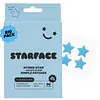What's inside
What's inside
 Key Ingredients
Key Ingredients

 Benefits
Benefits

 Concerns
Concerns

 Ingredients Side-by-side
Ingredients Side-by-side

 Reviews
Reviews

Ingredients Explained
These ingredients are found in both products.
Ingredients higher up in an ingredient list are typically present in a larger amount.
Salicylic Acid (also known as beta hydroxy acid or BHA) is a well-known ingredient for treating skin that struggles with acne and clogged pores. It exfoliates both the skin's surface and deep within the pores to help clear out buildup, control oil, and reduce inflammation.
Unlike AHAs (alpha hydroxy acids), salicylic acid is oil-soluble. This allows it to penetrate into pores which makes it especially effective for treating blackheads and preventing future breakouts.
Salicylic acid is also known for its soothing properties. It has a similar structure to aspirin and can calm inflamed or irritated skin, making it a good option for acne-prone skin that is also sensitive.
Concentrations of 0.5-2% are recognized by the U.S. FDA as an over-the-counter topical acne product.
It can cause irritation and/or dryness if one's skin already has a compromised moisture barrier, so it's best to focus on repairing that before introducing this ingredient into your routine.
While salicylic acid does not increase sun sensitivity, it’s still important to wear sunscreen daily to protect your skin.
If you are looking for the ingredient called BHA or Butylated Hydroxyanisole, click here.
Learn more about Salicylic AcidHydrocolloid is technically not an INCI ingredient. It is a type of material used to dress uninfected wounds.
Hydrocolloid is coated with a mix of gelatin, pectin, xanthan gum, carrageenan, and other biopolymers.
Hydrocolloid patches made for treating pimples often have other ingredients, such as tea tree oil, salicylic acid, niacinamide, glycolic acid, and more. Unfortunately, unless a company discloses this information, we won't have a way to know what other ingredients are present.
When hydrocolloid is applied to a wound, the polysaccharides and polymers absorb water to form a gel. These moist conditions help promote wound healing without breaking down cell tissue.
A study from 2021 found Hydrocolloid may aid in scar healing.
Learn more about Hydrocolloid